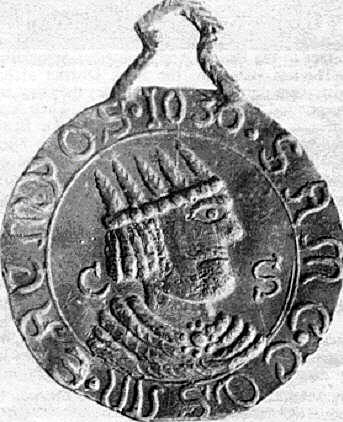The Billy and Charley Story - Page 1
| The Billy and Charley forgeries |
ROBERT HALLIDAY |
| DURING THE MIDDLE of the 19th century the London
archaeological community was disrupted by a controversy over the
authenticity of a large number of supposedly medieval leaden
objects that appeared for sale. They eventually proved to be
forgeries and have since been called "Billys and Charleys" after
their manufacturers. William Smith (Billy) and Charles Eaton (Charley), the eponymous forgers, are shadowy figures. It is even uncertain if Billy's name really was William Smith. But some biographical information can be found in writings on their forgeries. Charley was born in about 1834; Billy was probably born a few years earlier. Most of their life was spent in the neighbourhood of Rosemary Lane (now called Royal Mint Street) in Tower Hamlets. They were mudlarks who searched the Thames for items of value. William Edwards, a London antique dealer, made Billy's acquaintance around about 1845, and he met Charley some years later. He paid them for items of interest that they found, thinking of them as "his boys"1. Billy and Charley earned money from this until 1857, when they decided to counterfeit antiquities. They cast objects from lead (or lead alloys such as pewter), cutting dies into plaster of Paris moulds with nails and knives, and bathing the finished items in acid to simulate aging. Their commonest products were medallions, of between two and four inches in diameter, with small loops attached to form hangers (Fig. 1). Because of the primitive casting technique, they were generally thin, with poorly defined edges and pitted. uneven surfaces. Other products included daggers, statuettes, ampullae (Fig. 2) and even small shrines (Fig. 3). The figures most frequently depicted on these forgeries were knights in body-hugging armour (Fig. 4), kings wearing strange spiked crowns and priests in wide, loosely hanging robes, all with childish expressionless faces. Billy and Charley were illiterate, and the inscriptions on their forgeries consisted of meaningless jumbles of letters and symbols, while dates in arabic numerals ascribed manufacture to the years between the 11th and 16th centuries, although Arabic
|
numerals did not come into use in Europe before the 15th
century. Billy and Charley claimed to have found their creations at Shadwell, where a new dock was being built, and they found a ready market. The materials needed to make a medallion cost twopence, but one could be sold for half a crown, and larger items could sell for considerably more2. William Edwards became one of their principal customers, describing the objects as "The most interesting relics I have met with for years and the earliest pilgrims' signs that have yet been found"3. He showed them to George Eastwood. an antique dealer in the City Road, who bought large quantities, advertising them as "A remarkably curious and unique collection of leaden signs or badges of the time of Richard Il"4.
Fig. 1: a lead medallion by Billy and Charley (photo: Chris Mycock) |
